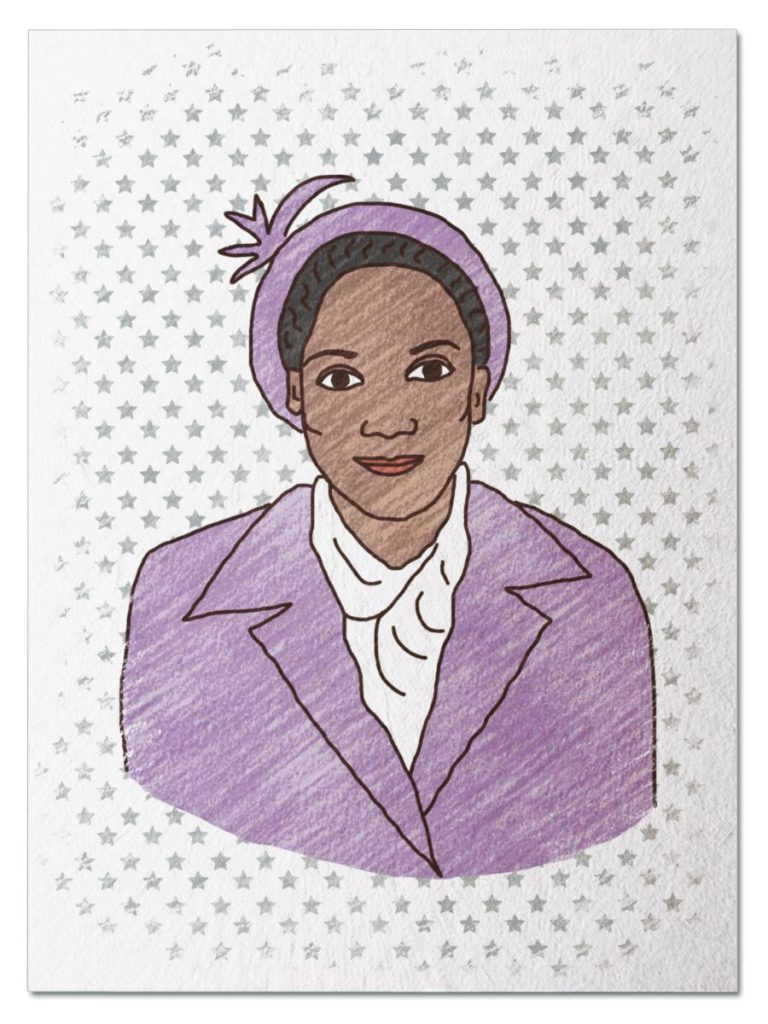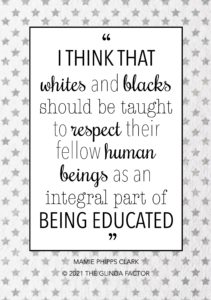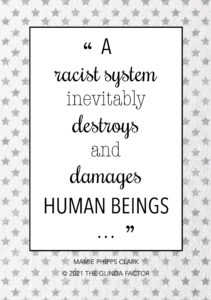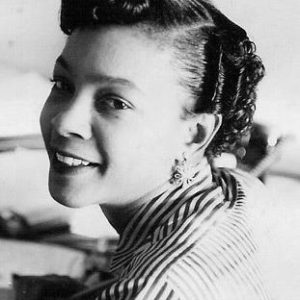
Health Hero
Her childhood experiences in the Jim Crow south fueled her passion for the new field of child development in psychology. Her research on the effects of segregation on Black children was a foundation for the landmark Supreme Court decision Brown v. Board of Education, which rejected “separate but equal” and ordered the desegregation of our nation’s schools. She did all this while founding and running the Northside Center for Child Development – the first of its kind for Black children. Step back in time to 1952 and meet Mamie Phipps Clark…
Her Ruby Shoe Moment
The Power of the Wand
Her Yellow Brick Road
Brains, Heart & Courage
Glinda’s Gallery
Just the Facts
Her Ruby Shoe Moment
Mamie Phipps Clark was excited to see her name in black and white. She was one of 35 scientists (and the only Black woman) who signed their names to a document called The Effects of Segregation and the Consequences of Desegregation: A Social Science Statement. It was September 22, 1952 and the NAACP just submitted the Statement to the US Supreme Court in connection with the case, Brown v. Board of Education of Topeka.
The Statement summarized the major research findings and various expert testimonies about the effects of racial segregation. It highlighted work by psychologists, psychiatrists, social workers, and anthropologists throughout America — including psychology experiments that Mamie and her husband, Kenneth, had conducted together over the years. It was the first time that social science was considered in a case before the Supreme Court.

The Doll Test, NAACP Legal Defense Fund
In some ways, the Statement was a culmination of her life’s work. Mamie had devoted her entire professional career to studying the effects of segregation on Black children. And she had been involved in the school de-segregaton movement for many years. In fact, Mamie testified as an expert witness in Davis v. School Board of Prince Edward County, the Virginia lawsuit that was eventually consolidated into the Brown case.
Mamie and Kenneth were best known for their Dolls Test, which they conducted in 1939, while she was in graduate school. In the Dolls Test, over 250 young Black children were shown 4 dolls that differed only in hair and skin color. Then, they asked the children to pick a doll in response to 8 different questions, such as “Show me the doll that you like the best or that you’d like to play with.” Their research showed that many of the Black children preferred the white dolls, referring to the white dolls as “nice” and the Black doll as “bad.” One of their conclusions was that segregation was harmful psychologically to Black children — they absorbed the stereotypes held by society and saw themselves negatively, which affected their development and self-esteem.
 When Supreme Court finally announced its decision in Brown in 1954, Mamie was thrilled. The Court unanimously held that segregation in schools on the basis of race was unconstitutional. And she could see her work echoed in the following language of the Court’s majority opinion:
When Supreme Court finally announced its decision in Brown in 1954, Mamie was thrilled. The Court unanimously held that segregation in schools on the basis of race was unconstitutional. And she could see her work echoed in the following language of the Court’s majority opinion:
To separate [Black children] from others of similar age and qualifications solely because of their race generates a feeling of inferiority as to their status in the community that may affect their hearts and minds in a way unlikely to ever be undone…
Even more, her husband’s publication was listed in a footnote that supported the Court’s conclusions. Despite the fact that Mamie’s name wasn’t listed as well, it was clear that her work made a big impact on the Court. And that was enough for her.
The Power of the Wand
Mamie’s work in psychology had a lasting impact on the Civil Rights Movement. Unfortunately, the harmful effects of discrimination are still a problem today. And some teens, like Kheris Rogers, are taking action to address it. When she was in elementary school, Kheris was bullied for the color of her skin. It was tough, but she knew in her heart that others have been in the same situation. So she and her sister turned to social media — they started #FlexinInMyComplexion on Twitter, which provides a space for Black girls to share their story, boost their self-esteem, and celebrate their inherent beauty. And Kheris didn’t stop there — she now has a clothing line that celebrates confidence and empowerment.
Her Yellow Brick Road
When Mamie and Kenneth moved to New York City, she applied to the doctorate psychology program at Columbia University. She knew it would be a tough road — it was her first experience with integrated education; she was the only Black woman in the program; and her advisor held racist views. But she was determined to continue with her studies.
While at Columbia University, Mamie built upon the research that she conducted at Howard University. She and Kenneth studied the impact of segregation on Black children — including their famous Doll Test. And they published three major articles about their work.

Mamie & Kenneth Clark, Columbia University
After Mamie received her PhD, she couldn’t find a job as a psychologist. Colleges weren’t interested in hiring a Black woman as a professor, and most of the children who received private psychological services were white (and didn’t want a Black therapist). Mamie was discouraged, but refused to give up. So she took a few jobs for which she was overqualified, but gave her experience in psychological research.
Then, Mamie took a position at Riverdale Children’s Association, where she performed psychological testing for homeless Black girls. It was a rewarding job and opened her eyes to the lack of resources available for Black children. She had found her passion!
Mamie spent more than a year going from agency to agent within New York City, trying to convince them to provide psychological services for Black children. But she got nowhere. So she started her own agency — Northside Center for Child Development. It was the first organization to provide psychological and educational services to Black children and families in Harlem. Her father loaned her the money for start-up costs, including a lease for space in the basement of their apartment building.
 Mamie recruited her friends to help — psychologists, psychiatrists and social workers all volunteered their time. And they were overwhelmed with families seeking their services. For example, parents came to Northside to get help when their Black child was put into special education classes. Northside volunteers conducted psychological tests that showed the children weren’t mentally disabled, therefore belong in mainstream classrooms. They also helped parents navigate the school system and advocated on the children’s behalf.
Mamie recruited her friends to help — psychologists, psychiatrists and social workers all volunteered their time. And they were overwhelmed with families seeking their services. For example, parents came to Northside to get help when their Black child was put into special education classes. Northside volunteers conducted psychological tests that showed the children weren’t mentally disabled, therefore belong in mainstream classrooms. They also helped parents navigate the school system and advocated on the children’s behalf.
Northside grew quickly. Before long, it had paid staff who provided a full range of services. And it became a center for advocacy in the Harlem community. Mamie dedicated the rest of her professional career to Northside, serving as its executive director for over 30 years.
Brains, Heart & Courage
Mamie grew up in a loving family in Alabama. Her father was a successful physician and her parents tried to protect her from the discrimination that was a part of everyday life in the Jim Crow South. Nevertheless, Mamie couldn’t escape the racism — she was exposed to a lynching when she was 6 years old and attended segregated schools.
 Mamie earned a full scholarship to Howard University, but quickly realized that her high school education was inferior to the students who were educated in the North. So she took summer classes to catch up. Mamie started as a math major, but found it too impersonal. Then she met Kenneth, who was a psychology major. They began to date and eloped when she was a senior in college. Mamie was intrigued by his studies, especially child development. So she switched her major and never looked back.
Mamie earned a full scholarship to Howard University, but quickly realized that her high school education was inferior to the students who were educated in the North. So she took summer classes to catch up. Mamie started as a math major, but found it too impersonal. Then she met Kenneth, who was a psychology major. They began to date and eloped when she was a senior in college. Mamie was intrigued by his studies, especially child development. So she switched her major and never looked back.
After Mamie graduated from Howard, she took a summer job as a secretary in the office of civil rights lawyer Charles Houston. While there, she was exposed to the layers of laws that segregated Black people from everyone else. Houston was involved in the early planning of civil rights cases to challenge those laws as unconstitutional. It was exciting.
That summer, Mamie realized that she had two passions — child development and racial equity. So she decided to combine them in the new field of developmental psychology. Mamie pursued a master’s degree at Howard University and focused on how Black students viewed themselves while attending segregated schools. Her decision about what to study was influenced by her experiences as a child, which gave her unique insight into the children who were involved in her research.
Glinda’s Gallery
Just the Facts
- Mamie was born on April 18, 1917 in Hot Springs, Arkansas. Her dad was a physician and her mom was a homemaker. She had a younger brother named Harold.
- Mamie attended segregated schools and graduated in 1934. She was offered scholarships to both Fisk University and Howard University (top Black colleges at the time). She started at Howard as a math major, but switched to psychology. She graduated in 1938, then went on to get a master’s degree.
- Mamie married Kenneth Clark in 1937. They secretly eloped when she was a senior in college. They had two children, Kate and Hilton.
- Mamie attended Columbia University in New York for her doctorate degree in psychology. She was the first Black woman to receive a psychology doctorate from Columbia. Her work focused on the psychological effects of segregation on Black children. She co-published her research with Kenneth, who got most of the recognition for their work.
- In 1946, Mamie and Kenneth opened the Northside Center for Child Development in Harlem, New York. She served as its executive director from 1946-1979. Northside provided support services to Black families, including tutoring, intellectual testing, nutrition, and parenting workshops.
- Mamie was also active in her community, serving on the Board of directors for Harlem Youth Opportunities Unlimited and other educational and philanthropic organizations. She was also involved in the creation of the national preschool program, Head Start.
- Mamie received a number of awards of the years, including the Candace Award for Humanitarianism from the National Coalition of 100 Black Women.
- Mamie died of lung cancer at age 66 on August 11, 1983 in New York City.
Want to Know More?
Clark, Mamie Phipps. 1976 “Notable New Yorkers” Interview with Ed Edwin. Columbia University Libraries Oral History Research Office (http://www.columbia.edu/cu/lweb/digital/collections/nny/clarkm/index.html)
Clark, K. B. & Clark, M. K. (1940). Skin color as a factor in racial identification of Negro preschool children. The Journal of Social Psychology, 11, 159-169.
Mamie Katherine Phipps Clark (1917–1983) (https://encyclopediaofarkansas.net/entries/mamie-katherine-phipps-clark-2938/)
Markowitz, Gerald, and David Rosner. Children, Race, and Power: Kenneth and Mamie Clark’s Northside Center. Charlottesville: University Press of Virginia, 1996.
McNeill, Leila. “How a Psychologist’s Work on Race Identity Helped Overturn School Segregation in 1950s America.” Smithsonian Magazine, October 26, 2017 (https://www.smithsonianmag.com/science-nature/psychologist-work-racial-identity-helped-overturn-school-segregation-180966934/).
O’Connell, Agnes and Nancy Felipe Russo, eds. Models of Achievement: Reflections of Eminent Women in Psychology. New York: Columbia University Press, 1983.
Warren, Wini. Black Women Scientists in the United States. Bloomington: Indiana University Press, 1999.
